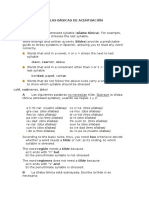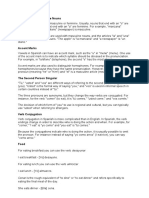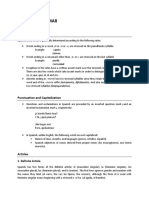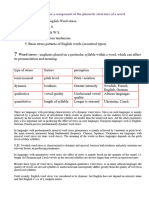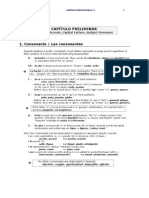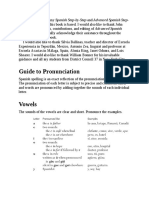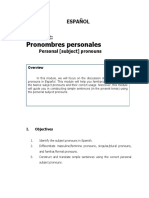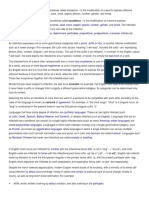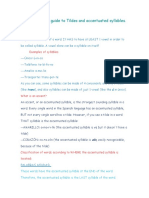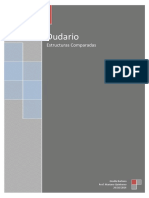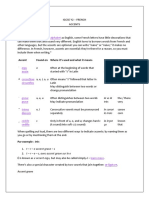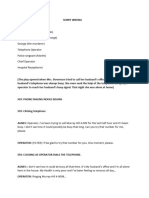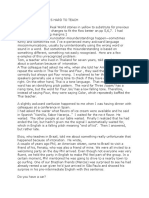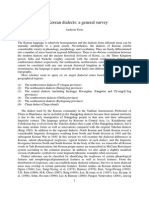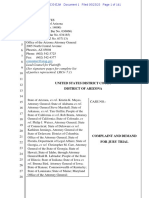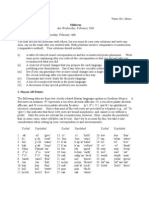0 ratings0% found this document useful (0 votes)
38 viewsEL ACENTO ESCRITO O TILDE - PPSX
EL ACENTO ESCRITO O TILDE - PPSX
Uploaded by
Hector CelisSpanish words are categorized into four types based on where stress falls: agudas (on the last syllable), llanas (second to last syllable), esdrújulas (third to last syllable), and sobresdrújulas (any preceding syllable). Tildes are used to mark stress on words that go against the typical stress patterns. For example, lápiz is normally stressed on the last syllable but has a tilde to show stress falls on the second to last. Tildes also distinguish between homophones like éste (this one, pronoun) and este (this one, adjective). Vowels are usually diphthongs when combined but a tilde marks a hiatus
Copyright:
© All Rights Reserved
Available Formats
Download as PPSX, PDF, TXT or read online from Scribd
EL ACENTO ESCRITO O TILDE - PPSX
EL ACENTO ESCRITO O TILDE - PPSX
Uploaded by
Hector Celis0 ratings0% found this document useful (0 votes)
38 views12 pagesSpanish words are categorized into four types based on where stress falls: agudas (on the last syllable), llanas (second to last syllable), esdrújulas (third to last syllable), and sobresdrújulas (any preceding syllable). Tildes are used to mark stress on words that go against the typical stress patterns. For example, lápiz is normally stressed on the last syllable but has a tilde to show stress falls on the second to last. Tildes also distinguish between homophones like éste (this one, pronoun) and este (this one, adjective). Vowels are usually diphthongs when combined but a tilde marks a hiatus
Original Title
EL ACENTO ESCRITO O TILDE.ppsx
Copyright
© © All Rights Reserved
Available Formats
PPSX, PDF, TXT or read online from Scribd
Share this document
Did you find this document useful?
Is this content inappropriate?
Spanish words are categorized into four types based on where stress falls: agudas (on the last syllable), llanas (second to last syllable), esdrújulas (third to last syllable), and sobresdrújulas (any preceding syllable). Tildes are used to mark stress on words that go against the typical stress patterns. For example, lápiz is normally stressed on the last syllable but has a tilde to show stress falls on the second to last. Tildes also distinguish between homophones like éste (this one, pronoun) and este (this one, adjective). Vowels are usually diphthongs when combined but a tilde marks a hiatus
Copyright:
© All Rights Reserved
Available Formats
Download as PPSX, PDF, TXT or read online from Scribd
Download as ppsx, pdf, or txt
0 ratings0% found this document useful (0 votes)
38 views12 pagesEL ACENTO ESCRITO O TILDE - PPSX
EL ACENTO ESCRITO O TILDE - PPSX
Uploaded by
Hector CelisSpanish words are categorized into four types based on where stress falls: agudas (on the last syllable), llanas (second to last syllable), esdrújulas (third to last syllable), and sobresdrújulas (any preceding syllable). Tildes are used to mark stress on words that go against the typical stress patterns. For example, lápiz is normally stressed on the last syllable but has a tilde to show stress falls on the second to last. Tildes also distinguish between homophones like éste (this one, pronoun) and este (this one, adjective). Vowels are usually diphthongs when combined but a tilde marks a hiatus
Copyright:
© All Rights Reserved
Available Formats
Download as PPSX, PDF, TXT or read online from Scribd
Download as ppsx, pdf, or txt
You are on page 1of 12
EL ACENTO ESCRITO O TILDE
Fuente: e Learn Spanish Language
http://www.spanishdict.com
Fuente: e Learn Spanish Language
http://www.spanishdict.com
In Spanish words are divided into four categories
according to their stress: sobresdrújulas,
esdrújulas, llanas, and agudas. Llanas and agudas
account for almost 90% of all Spanish words.
Aguda – These are words which are
stressed on the last syllable. If they end in a
consonant other than 'n' or 's' or in a
vowel, they have no written tilde. About
1/3 of all Spanish words are agudas,
including all infinitives.
avestruz, matador, hablar
Llana - These are words which are
stressed on the second to last (penult)
syllable. If they end in a vowel, 'n', or
's' they have no written tilde. Over half
of all Spanish words are llanas.
mono, cantan, computadoras
Esdrújula – These are words whose stress falls on
the third to last (antepenult) syllable. They always
have a tilde.
rápido, América, clásico
Sobreesdrújula – These are words whose accent
falls on any syllable preceding the third to last. The
only words with this stress are verb forms with one
or two unstressed pronouns attached to them.
These words always have a tilde.
míramelo, préstasela, devolviéndonoslas
In order to pronounce words correctly, you
will need to know the natural (usual) stress
patterns of Spanish. For words without a
written
tilde,
1. If a word ends in n, s, or a vowel (vocal),
the word is llana and stress falls on the next-
to-last syllable (penúltima sílaba).
Repitan llamas hola
↑ ↑ ↑
2. If a word without a tilde ends in any
consonant (consonante) other than n or s, the
word is aguda and stress falls on the last
syllable (última sílaba).
español usted regular
↑ ↑ ↑
3. Any exception to rules 1 and 2 must have a written
accent mark (tilde o acento ortográfico) on the stressed
vowel.
Below, the underlined syllable represents where the stress
would be if there was no written mark, whereas the arrow
(↑) shows where the stress actually is when the word is
pronounced. Since the two do not coincide, the above
rules for pronouncing do not give the right result, and a
written accent is needed on the stressed vowel to let the
reader know that the regular rules have been broken and a
different syllable must be stressed.
televisión teléfono lápiz
↑ ↑ ↑
Monosyllables (words consisting of only one syllable)
do not need an accent mark since that is the only
stressed vowel. Certain monosyllables, however, have
a written accent to distinguish them from similar
words that are pronounced the same but have
different meanings:
Demonstrative pronouns: The words
ese, esa, esos, esas, este, esta, estos,
estas, aquel, aquella, aquellos,
aquellas can be adjectives or pronouns.
An accent is used on the pronoun to
distinguish it from the adjective.
Ese lápiz no es mío. Éste es el mío.
Note: The words esto, eso, aquello are
always pronouns and never have an
accent mark.
¿De quién es esto?
Interrogatives such as cómo, qué,
dónde, cuándo, cuál, etc. always have
accents when they are used as
questions or exclamations:
¿Cuándo llegas, hoy? ¡Qué bien!
They have no accent when they are
used as conjunctions or pronouns:
Eso está donde lo dejaste.
Cuando quieras, hablamos.
Vowels – Diphthongs and Hiatus
When you have two vowels together the stress
naturally goes on the strong vowel (a, e, o) and
we usually get a diphthong (two vowels in one
syllable) when they combine with one of the
weak vowels (u, i):
bueno, cuota, viaje, aire, peine, oigan
However, if the word stress is on the weak
vowel (i, u), then this vowel must show an
accent to mark a hiatus, and that it belongs in
its own syllable. The diphthong disappears:
tíos, reímos, salían, gradúen, ahí.
↑ ↑ ↑ ↑ ↑
You might also like
- Worksheet Practice Using Accents in SpanishDocument9 pagesWorksheet Practice Using Accents in SpanishGraceDarida33% (3)
- Spanish Adjectives and Adverbs ListDocument52 pagesSpanish Adjectives and Adverbs ListShelly Clarke100% (5)
- Repaso de Las Tildes y Las Silabas PDFDocument2 pagesRepaso de Las Tildes y Las Silabas PDFAnthony BensonNo ratings yet
- Mandoa GrammarDocument3 pagesMandoa GrammarKenar716No ratings yet
- Spanish Grammar: a QuickStudy Laminated Reference GuideFrom EverandSpanish Grammar: a QuickStudy Laminated Reference GuideRating: 4 out of 5 stars4/5 (8)
- Minimal PairsDocument3 pagesMinimal PairsMikee Hannah MapaNo ratings yet
- Sounds To Graphemes Guide: David NewmanDocument81 pagesSounds To Graphemes Guide: David NewmanSonia FelipeNo ratings yet
- Tier 2 Intervention Phonemic AwarenessDocument207 pagesTier 2 Intervention Phonemic Awarenessaamir.saeed100% (2)
- El Acento Escrito o Tilde-2Document12 pagesEl Acento Escrito o Tilde-2Shaminika DavidsNo ratings yet
- Lesson 3 Accentuation and Others 1Document4 pagesLesson 3 Accentuation and Others 1JhuNo ratings yet
- Less 2 Spanish Punctuation SpellingDocument13 pagesLess 2 Spanish Punctuation SpellingJamar Armenta GonzalezNo ratings yet
- Reglas de AccentosDocument3 pagesReglas de AccentosAny L HenaoNo ratings yet
- SOL - Skool Of Languages (సోల్ - స్కూ ల్ ఆఫ్ లాంగ్వే జెస్) : Teaching PlanDocument1 pageSOL - Skool Of Languages (సోల్ - స్కూ ల్ ఆఫ్ లాంగ్వే జెస్) : Teaching PlanSai Babu DhulipalaNo ratings yet
- Masculine and Feminine Nouns: Cenar Is The Rough Equivalent of "To Dine" or "To Eat Dinner" and Refers Specifically ToDocument5 pagesMasculine and Feminine Nouns: Cenar Is The Rough Equivalent of "To Dine" or "To Eat Dinner" and Refers Specifically ToRobin KhatriNo ratings yet
- Introduction and Review: EspañolDocument14 pagesIntroduction and Review: EspañolAlmyr Jay JimenezNo ratings yet
- Accentuation, Punctuation, ArticleDocument3 pagesAccentuation, Punctuation, ArticleEmilNo ratings yet
- SPN2 / Instructor: Gonzalo Díaz-Letelier Department of Spanish, University of California RiversideDocument1 pageSPN2 / Instructor: Gonzalo Díaz-Letelier Department of Spanish, University of California RiversideGonzalo Díaz-LetelierNo ratings yet
- Tamil SolutionsDocument3 pagesTamil Solutionsஜீனோ கார்த்திக்No ratings yet
- Spanish Letters With TildesDocument2 pagesSpanish Letters With TildesYasar YasarlarNo ratings yet
- Differences Spanish RomanianDocument7 pagesDifferences Spanish RomanianScribdTranslationsNo ratings yet
- Stress Rhythm Weak FormsDocument30 pagesStress Rhythm Weak Formsheinz0% (1)
- Al ArtículoDocument7 pagesAl ArtículoTexeneryNo ratings yet
- Rules For Accent Marks in SpanishDocument5 pagesRules For Accent Marks in SpanishAna Jaen100% (1)
- L 4 Table Alina RosaDocument8 pagesL 4 Table Alina RosaAlina RosaNo ratings yet
- Grčki Akcenatski SistemDocument3 pagesGrčki Akcenatski SistemMarija JovanovićNo ratings yet
- Capítulo Preliminar: Spelling, Accents, Capital Letters, Subject PronounsDocument7 pagesCapítulo Preliminar: Spelling, Accents, Capital Letters, Subject PronounsEnrique YepesNo ratings yet
- 2.3 El AcentoDocument14 pages2.3 El AcentoIra Rayzel JiNo ratings yet
- PhonemesDocument10 pagesPhonemesFanni MajorNo ratings yet
- SP GramDocument5 pagesSP GramIrena StojadinovicNo ratings yet
- Adjectives - AdjetivosDocument1 pageAdjectives - AdjetivosMichael HopkinsNo ratings yet
- Archivo de EspañolDocument18 pagesArchivo de EspañolKira ProfNo ratings yet
- Pronombres Personales: EspañolDocument5 pagesPronombres Personales: EspañolAlmyr Jay JimenezNo ratings yet
- English - SpanishDocument12 pagesEnglish - SpanishONLINE STUDENTNo ratings yet
- Conjugation: Write, Wrote, Written (Marking byDocument4 pagesConjugation: Write, Wrote, Written (Marking byNylilav Enish Lagdamen NimbraNo ratings yet
- GramarDocument13 pagesGramargoldsunrise8No ratings yet
- Spanish VerbsDocument26 pagesSpanish Verbstengohueva100% (1)
- Spanish 101: Lección 1Document14 pagesSpanish 101: Lección 1Rose Jay VIDALNo ratings yet
- A Guide To Tildes and Accentuated SyllablesDocument3 pagesA Guide To Tildes and Accentuated SyllablesJuliana Lopez MartinezNo ratings yet
- Word Stress in Polysyllabic Words - 20240501 - 103217 - 0000Document14 pagesWord Stress in Polysyllabic Words - 20240501 - 103217 - 0000Julieta GonzálezNo ratings yet
- Middle English MorphologyDocument14 pagesMiddle English MorphologyНаталія Атлас0% (1)
- EspanolDocument53 pagesEspanolalakin87No ratings yet
- The Present Tense of Regular - Ar VerbsDocument18 pagesThe Present Tense of Regular - Ar VerbsDoctoraHolderNo ratings yet
- Poem Analysis - Part 1-For MidtermDocument29 pagesPoem Analysis - Part 1-For MidtermGuljan NamazovaNo ratings yet
- Word AttackDocument4 pagesWord AttackmirandamariakatrinaNo ratings yet
- Spanish Grammar Guide For English SpeakersDocument49 pagesSpanish Grammar Guide For English SpeakersAngeli MaturanNo ratings yet
- IV. Spanish and Subjunctive: A. Present Subjunctive (-Ar, - Er, - Ir) in SpanishDocument9 pagesIV. Spanish and Subjunctive: A. Present Subjunctive (-Ar, - Er, - Ir) in Spanishหวาน หวาน กำลังดีNo ratings yet
- Dudario de Estructuras Comparadas en Ingles y EspanolDocument63 pagesDudario de Estructuras Comparadas en Ingles y EspanolPepeNo ratings yet
- Phonology IiDocument9 pagesPhonology IiMoiraAcuñaNo ratings yet
- Unit One Prominence .Fundamental Concepts of The Theory of ProminenceDocument16 pagesUnit One Prominence .Fundamental Concepts of The Theory of Prominence10enero88No ratings yet
- Spoken Marathi Reference GrammarDocument93 pagesSpoken Marathi Reference Grammarmikembad83% (6)
- Introduction To The Spanish Language: PronunciationDocument11 pagesIntroduction To The Spanish Language: Pronunciationteacher fernandoNo ratings yet
- French AccentsDocument3 pagesFrench AccentsSaloni ParikhNo ratings yet
- Spanish 1Document96 pagesSpanish 1PennyNo ratings yet
- El Abecedario Español Está Compuesto de 27 Letras + 5 Difragos (Composiciones de Dos Letras: Ch/ll/gu/qu/rr)Document5 pagesEl Abecedario Español Está Compuesto de 27 Letras + 5 Difragos (Composiciones de Dos Letras: Ch/ll/gu/qu/rr)anastasiaNo ratings yet
- Kristo-Ch 7 PDFDocument31 pagesKristo-Ch 7 PDFHafid Tlemcen Rossignol PoèteNo ratings yet
- Accentuation Explained 2014Document2 pagesAccentuation Explained 2014api-273436119No ratings yet
- Felipe Arroyo de La Cuesta - Extracto de La GramáaticaDocument47 pagesFelipe Arroyo de La Cuesta - Extracto de La GramáaticaBritany OrqueraNo ratings yet
- Basic Rules of Accentuation, SpanishDocument3 pagesBasic Rules of Accentuation, SpanishJulia LeshanNo ratings yet
- 1001 Most Useful Spanish Words NEW EDITIONFrom Everand1001 Most Useful Spanish Words NEW EDITIONRating: 4 out of 5 stars4/5 (1)
- Morphological Stylistics. Phonetic and Graphic Expressive Means and Stylistic DevicesDocument65 pagesMorphological Stylistics. Phonetic and Graphic Expressive Means and Stylistic DevicesTania ShramNo ratings yet
- Lesson 4 (Stress and Intonation)Document54 pagesLesson 4 (Stress and Intonation)Zarah CaloNo ratings yet
- French DuoDocument26 pagesFrench DuoDaniela CascoNo ratings yet
- KX-T61610B ManualDocument12 pagesKX-T61610B ManualHesham ElsayedNo ratings yet
- LG Aria 24 130 26 300 ProgrammingDocument233 pagesLG Aria 24 130 26 300 ProgrammingDayalan Vino80% (5)
- Sorry Wrong NumberDocument13 pagesSorry Wrong NumbertahollenirobredogNo ratings yet
- Creation of PRA - Procedure For OCB283Document9 pagesCreation of PRA - Procedure For OCB283Jayakrishna ReddyNo ratings yet
- English - Pronunciaiton KeyDocument2 pagesEnglish - Pronunciaiton KeyAnbRaoNo ratings yet
- Panduan Niat&do'a Bulan RamadhanDocument38 pagesPanduan Niat&do'a Bulan RamadhanKhurin 'InNo ratings yet
- 12 R-Coloured Vowels in Irish English (Hickey)Document13 pages12 R-Coloured Vowels in Irish English (Hickey)encike0317No ratings yet
- Abstractness in PhonologyDocument27 pagesAbstractness in PhonologyjagiyaaNo ratings yet
- Voice Over Internet ProtocolDocument17 pagesVoice Over Internet Protocolguru0416100% (4)
- Speech OrgansDocument5 pagesSpeech OrgansprivateceeNo ratings yet
- Myth. by GlibretDocument20 pagesMyth. by GlibretWagdi Bin-HadyNo ratings yet
- Vowels and Consonants PhoneticsDocument27 pagesVowels and Consonants PhoneticsAdriana SuciuNo ratings yet
- Hungarian: Below Is Hungarian Phonetic Vowel Chart and The Scale of Vowel MarkednessDocument4 pagesHungarian: Below Is Hungarian Phonetic Vowel Chart and The Scale of Vowel MarkednessJoshua HernandezNo ratings yet
- Hausa Tonology - Complexities in An "Easy" Tone LanguageDocument17 pagesHausa Tonology - Complexities in An "Easy" Tone LanguageOpa YatNo ratings yet
- Icelandic For BegineersDocument4 pagesIcelandic For BegineersAMPARO100% (1)
- How To Kill Your Foreign Accent (Robby's Accent Adventure)Document24 pagesHow To Kill Your Foreign Accent (Robby's Accent Adventure)Lucas Pestana100% (1)
- Signalling in TelecommunicationDocument17 pagesSignalling in TelecommunicationEarnest JayakaranNo ratings yet
- Manual Panasonic ADVANCED HYBRID KX-TEB308Document152 pagesManual Panasonic ADVANCED HYBRID KX-TEB308Roberto IsidaNo ratings yet
- Text12 PDFDocument24 pagesText12 PDFharishreddy1985No ratings yet
- TLoJaK 06 Korean Dialects - FinalDocument18 pagesTLoJaK 06 Korean Dialects - FinalElias CarvalhoNo ratings yet
- Daypo SAEDocument9 pagesDaypo SAEMaria.Fer79No ratings yet
- Operating Instructions: KX-TCA155Document54 pagesOperating Instructions: KX-TCA155thaiNo ratings yet
- Distinctive Features - Vowels: Open/CloseDocument2 pagesDistinctive Features - Vowels: Open/CloseStojan SavicNo ratings yet
- Aspects of Connected SpeechDocument20 pagesAspects of Connected SpeechKyrillKayFL0% (1)
- Alfred Snider - Code of The Debater: Introduction To Policy DebateDocument222 pagesAlfred Snider - Code of The Debater: Introduction To Policy DebateBrett BatistaNo ratings yet
- Conformed Complaint AvidDocument141 pagesConformed Complaint AvidNBC MontanaNo ratings yet
- Midterm 11Document2 pagesMidterm 11Hashim Ahmed هآشم احمدNo ratings yet











